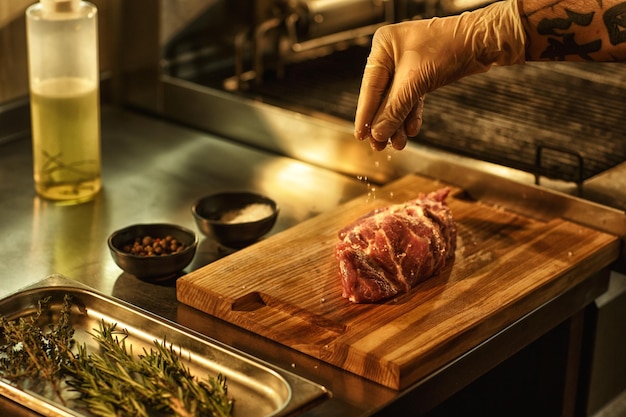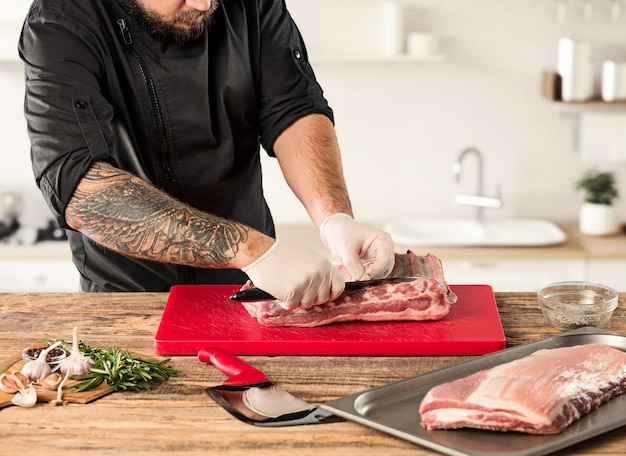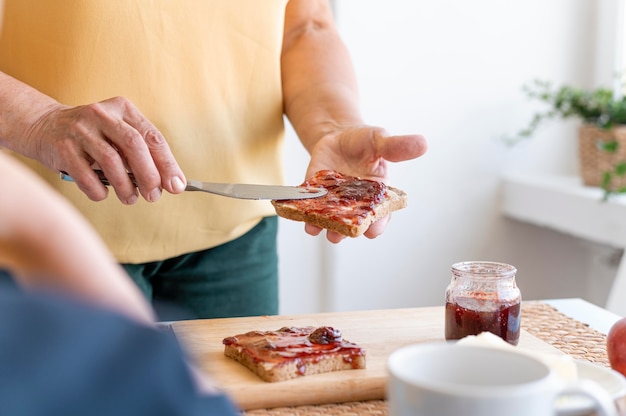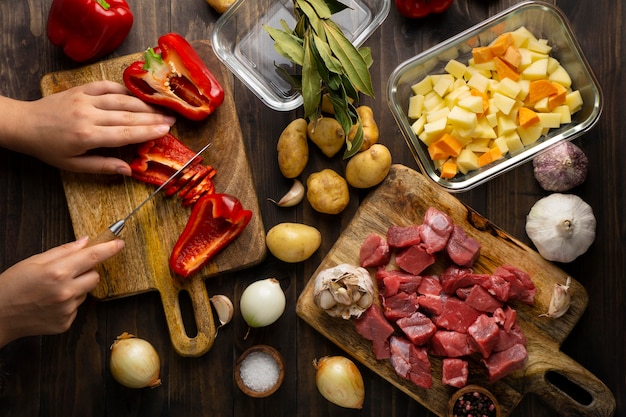You know that feeling – you’re craving a hearty, satisfying meal, but you don't want to spend hours in the kitchen. Enter the humble pork steak: a quick-cooking, versatile, and budget-friendly protein that, when cooked right, can be a real culinary delight. But let’s be honest, there’s nothing worse than a dry, overcooked pork steak. That’s why I’ve put together this guide, packed with tips and tricks I've picked up over years of experimenting in the kitchen. We’re going to dive deep into choosing the perfect cut, mastering different cooking methods, and even exploring ways to make the most of your leftovers. So grab your apron, gather your ingredients, and let’s get cooking!
(Part 1) The Pork Steak: A Bit of Background
Choosing the Right Pork Steak

First things first, you need to pick the right cut. Now, I’ve tried them all, and trust me, there’s a world of difference between a thin, tough pork chop and a juicy, flavorful pork steak. My go-to cut is the pork loin, which is often sold in the butcher’s as a “pork steak.” It’s lean, tender, and cooks up beautifully. It’s also a great source of protein and vitamins, making it a healthy choice for a delicious dinner.
But don’t be afraid to branch out! You can also find pork tenderloin, which is even more tender and melts in your mouth. However, it’s a bit more expensive and typically best for quick cooking methods. Then there’s pork belly, which is a bit fattier and will give you a more flavorful steak. Just be mindful that it can be quite rich and might require a bit more attention to avoid overcooking.
The Art of Butchering

Remember, you’re not just choosing a steak, you’re choosing an adventure. So, I often head to the butcher’s and have a chat. They’re usually more than happy to cut you a pork steak that’s perfect for your needs. They can advise you on which cut will be best for your chosen cooking method and even recommend specific seasonings to enhance the flavor.
Butchering: The Pros and Cons
Pros: You can get a steak cut to your exact thickness, which is ideal for a perfect cook. They can also trim the fat to your preference, ensuring a leaner or richer steak depending on your taste.
Cons: It might cost a little more than buying pre-packaged cuts at the supermarket.
The Importance of Thickness

The thickness of your steak is crucial. If it’s too thin, it’ll cook too quickly and risk drying out. A thicker steak will give you more time to cook it evenly and achieve that juicy perfection. A thicker steak will also hold more moisture, resulting in a more succulent bite.
Pork Steak Thickness: A Guide
Thin (under ?? inch): Great for pan-frying or grilling, but needs to be cooked carefully to avoid drying out. Use high heat and watch it closely to avoid burning.
Medium (?? - 1 inch): This is my favorite thickness for a juicy steak that can be cooked over medium heat. It provides a balance of tenderness and flavor.
Thick (over 1 inch): Best for slow cooking methods like braising or roasting. This allows for even cooking throughout the steak and creates a more tender and flavorful result.
(Part 2) The Preparation Game: It's All About the Details
The Trimming and Cleaning Process
Once you’ve got your chosen pork steak, you need to prepare it. First, I like to trim any excess fat. You don’t want to remove all of it, as some fat adds flavor and helps keep the steak moist. A thin layer of fat will render down during cooking, adding richness to the steak. But if you prefer a leaner steak, you can trim most of the fat. Then, give it a good wash under cold water and pat it dry with paper towels.
The Marination Magic
Now, this is where things get fun! Marinating your pork steak can really elevate the flavor. I’ve tried all sorts of marinades, but I always find myself coming back to simple combinations. You can stick to classics like olive oil, lemon juice, and herbs, or get a little adventurous with soy sauce, ginger, and garlic. A marinade not only adds flavor but also helps to tenderize the meat, making it even more juicy and flavorful.
Marination Tips: Don’t Be Afraid to Experiment
Time is key: A marinade will work its magic best if you leave it for at least 30 minutes, but an overnight marinade is even better. The longer the marinade sits, the more flavorful your steak will become.
Flavour Fusion: Be creative! Combine different flavors and experiment until you find a combination you love. For example, a sweet and savory marinade with honey, soy sauce, and ginger, or a citrusy marinade with orange juice, garlic, and rosemary.
The Marinating Container: Use a container with a tight-fitting lid to ensure the marinade covers the steak evenly. I often use a resealable plastic bag, which allows the marinade to penetrate the steak more effectively.
The Seasoning Savvy
Once your steak is marinated, it’s time to season it. I like to use a simple salt and pepper mix. However, you can also add other spices like garlic powder, paprika, or even a little cayenne pepper for a kick. Don't be afraid to get creative with your seasonings, but remember to season lightly so you don't overwhelm the natural flavor of the pork.
Seasoning Techniques:
Salt and Pepper: A classic combination for a reason! Salt helps to draw out moisture, making the steak more tender, while pepper adds a bit of heat.
Spice Blends: Use pre-made spice blends or create your own with your favourite spices. I love using a blend of smoked paprika, cumin, and chili powder for a smoky and spicy flavor.
Seasoning Right Before Cooking: Avoid over-seasoning, as the salt will draw out moisture. Season the steak liberally right before cooking, allowing the salt to penetrate the surface and enhance the flavor.
(Part 3) The Cooking Craft: Mastering the Heat
Grilling: The Outdoor Delight
Now, we're getting to the good stuff. Grilling is definitely a crowd-pleaser. I love the smoky flavour that grilling adds to pork steaks. It's a great way to cook outdoors on a sunny day and enjoy the fresh air.
Grilling: Tips for Success
Preheating Power: Let your grill heat up for at least 10 minutes before placing your steak on it. This ensures that the grill is hot enough to sear the steak properly and create those beautiful grill marks.
Grill Marks: Get those beautiful grill marks by placing your steak on a hot grill and cooking it for 2-3 minutes per side. The initial sear helps to create a flavorful crust and lock in moisture.
Indirect Heat: After those initial grill marks, move your steak to a cooler part of the grill to finish cooking. This helps to prevent the steak from burning while ensuring it cooks through evenly.
Pan-Frying: The Indoor Masterpiece
Don't have a grill? No problem. Pan-frying is a great alternative. I find that a cast-iron pan works best, as it distributes heat evenly and gives the steak a lovely crust. You can also use a stainless steel pan, just make sure it's well-seasoned for even browning.
Pan-Frying: Essential Techniques
Sizzle Test: Add a drop of water to your hot pan. If it sizzles immediately, it’s ready for your steak. This is a good indicator that your pan is hot enough to sear the steak properly.
Don't Overcrowd: Give each steak space in the pan for even cooking. Crowding the pan will reduce the heat and prevent the steak from browning properly.
Flip Only Once: Flip the steak once it's nicely browned on one side and the juices run clear. This helps to prevent the steak from drying out and ensures that it cooks evenly throughout.
Oven Cooking: The Easy Option
Okay, let’s be honest, sometimes you just want a simple solution. Oven cooking is a great way to cook pork steaks without any fuss. It’s also a great option for cooking multiple steaks at once.
Oven Cooking: A Step-by-Step Guide
1. Preheat: Preheat your oven to 375°F (190°C). This ensures that the oven is hot enough to cook the steak evenly and create a delicious crust.
2. Bake: Place your steak on a baking sheet and cook for 15-20 minutes, or until the internal temperature reaches 145°F (63°C). For a thicker steak, you might need to cook it for a bit longer.
3. Rest: Let your steak rest for 5-10 minutes before slicing and serving. This allows the juices to redistribute throughout the steak, resulting in a more tender and flavorful final product.
(Part 4) The Temperature Tango: Knowing When It's Done
The Internal Temperature Game
You've heard it before, but it's worth repeating – don't overcook your pork! Overcooked pork can be dry and tough. The best way to know when your pork steak is perfectly cooked is to use a meat thermometer.
Internal Temperatures: A Guide for Pork Steaks
Medium-Rare: 140-145°F (60-63°C) – The steak will have a pinkish hue and be juicy and tender.
Medium: 145-150°F (63-66°C) – The steak will have a slight pink hue and be firm to the touch.
Medium-Well: 150-155°F (66-68°C) – The steak will have a grayish hue and be firm to the touch.
Well Done: 160°F (71°C) – The steak will be grey throughout and be firm to the touch. It will be the least juicy but also the safest to eat.
The Visual Clues
While a thermometer is the most reliable way to gauge doneness, there are some visual clues to help you.
Visual Clues: What to Look For
Color: Pork that is cooked to medium-rare will have a pinkish hue, while medium-well pork will be more grey.
Juices: When you press the steak, clear juices will indicate it's cooked through, while pink or bloody juices mean it needs more time.
Texture: A well-cooked pork steak will be tender and juicy, while an overcooked steak will be dry and tough.
(Part 5) Resting and Slicing: Finishing Touches
The Importance of Rest
After you've taken your steak off the heat, it's important to let it rest for 5-10 minutes before slicing. This allows the juices to redistribute throughout the steak, resulting in a more tender and flavorful final product. The steak will also continue to cook slightly during this resting period, ensuring that it reaches the desired internal temperature.
The Slicing Techniques: Get Creative
Now it’s time for the final stage – slicing your pork steak. You can slice it against the grain for a more tender texture, or cut it across the grain for a more substantial bite. Slicing against the grain means cutting perpendicular to the direction of the muscle fibers, which helps to break them down and create a more tender texture. Cutting across the grain, on the other hand, creates thicker slices that are more substantial to chew.
Slicing Tips:
Slice Thin: For a more elegant presentation, slice your steak thin. This is perfect for serving with a salad or other light dishes.
Cut into Strips: Cut the steak into strips for a more rustic presentation. This is great for sandwiches, stir-fries, or serving with pasta.
(Part 6) The Serving Spectacular: Flavorful Accompaniments
The side dishes: Complementary Flavors
What’s a pork steak without some fantastic side dishes? I like to pair it with something light and fresh, like a salad or roasted vegetables. This helps to balance out the rich flavor of the pork and provide a complete and satisfying meal.
Side Dish Ideas: Make it a Feast
Green Salad: A simple salad with leafy greens, tomatoes, and a vinaigrette dressing. A light and refreshing salad will contrast nicely with the richness of the pork steak.
Roasted Vegetables: Roasted root vegetables like carrots, potatoes, and sweet potatoes provide a hearty counterpoint. They complement the savory flavors of the pork steak and add a touch of sweetness to the meal.
Macaroni and Cheese: A comforting and cheesy side that pairs well with the savory flavors of pork steak. It's a classic combination that is always a crowd-pleaser.
mashed potatoes: creamy mashed potatoes add a touch of elegance to the meal. They provide a smooth and creamy texture that contrasts nicely with the firm texture of the pork steak.
The Sauces: A Final Touch
For a final touch, add a sauce to your pork steak. It can be as simple as a drizzle of olive oil and lemon juice, or you can get more elaborate with a homemade gravy or a creamy mushroom sauce. A sauce can really elevate the flavor of your pork steak, adding a burst of richness or a touch of acidity.
Sauce Ideas:
Pan Sauce: Use the drippings from the pan to create a flavorful sauce. Deglaze the pan with a little wine or broth and whisk in some butter and herbs for a quick and easy sauce.
Gravy: A classic gravy made with meat juices, flour, and broth. It's a hearty and comforting sauce that pairs well with roasted vegetables or mashed potatoes.
Mushroom Sauce: A rich and savory sauce made with mushrooms, butter, and wine. It's a delicious and elegant sauce that complements the savory flavors of the pork steak.
(Part 7) The Leftover Love: Making the Most of Your Steak
Storing Leftovers: Keep It Fresh
Leftover pork steak can be stored in the refrigerator for up to 3 days. Just wrap it tightly in plastic wrap or foil. This helps to prevent the steak from drying out and keeps it fresh for longer.
Storing Tips:
Refrigerate Quickly: Place the leftovers in the refrigerator as soon as possible to prevent bacterial growth. The sooner you refrigerate your leftovers, the fresher they will remain.
Label and Date: Label the container with the date so you know when it needs to be eaten. This will help to avoid food waste and ensure that you eat your leftovers before they go bad.
Leftover Transformations: Get Creative
Don't let those leftover pork steaks go to waste! There are so many ways to transform them into delicious meals.
Leftover Ideas:
Pork Steak Salad: Dice the leftover steak and add it to a salad. You can toss the steak with a vinaigrette dressing and some crunchy vegetables for a light and satisfying meal.
Pork Steak Sandwiches: Slice the steak thinly and use it for sandwiches. You can layer it with cheese, lettuce, tomato, and your favorite sauce for a hearty and delicious sandwich.
Pork Steak Stir-fry: Slice the steak and add it to a stir-fry with vegetables and your favorite sauce. Stir-frying is a great way to use up leftover steak quickly and add some extra vegetables to your meal.
Pork Steak Soup: Use the leftover steak in a hearty soup. You can add the steak to a vegetable soup, a potato soup, or even a noodle soup for a satisfying and flavorful meal.
(Part 8) FAQs: Your Pork Steak Questions Answered
FAQs: The Pork steak guide
Q: What is the best temperature for cooking pork steaks?
A: The best internal temperature for pork steaks is 145°F (63°C). This ensures that the steak is cooked through but still juicy and tender. Always use a meat thermometer to check the internal temperature of your pork steak.
Q: How long should I cook a pork steak?
A: The cooking time for a pork steak will vary depending on the thickness of the steak and the method of cooking. A thin steak will cook much faster than a thick steak. Always check the internal temperature of the steak to ensure it is cooked to your desired doneness.
Q: What are some good ways to prevent pork steaks from drying out?
A: To prevent pork steaks from drying out, cook them over medium heat and use a meat thermometer to ensure they are not overcooked. You can also marinate the steaks before cooking to help retain moisture. Don't overcook your steak, as this will make it dry and tough.
Q: What are some good marinades for pork steaks?
A: Some good marinades for pork steaks include:
Lemon-Herb Marinade: Olive oil, lemon juice, garlic, rosemary, and thyme. This marinade adds a bright and flavorful touch to the pork steak.
Honey-Soy Marinade: Honey, soy sauce, ginger, and garlic. This marinade adds a sweet and savory flavor to the pork steak.
Apple Cider Marinade: Apple cider vinegar, olive oil, garlic, and paprika. This marinade adds a tangy and flavorful touch to the pork steak.
Q: What are some good side dishes to serve with pork steaks?
A: Some good side dishes to serve with pork steaks include:
Roasted Vegetables: Carrots, potatoes, broccoli, and Brussels sprouts. Roasted vegetables add a hearty and flavorful side dish to your pork steak meal.
Green Salad: A simple salad with leafy greens, tomatoes, and a vinaigrette dressing. A green salad provides a refreshing and light contrast to the richness of the pork steak.
Mashed Potatoes: Creamy mashed potatoes. Mashed potatoes are a classic side dish that pairs well with the savory flavors of pork steak.
rice pilaf: A fluffy and flavorful rice dish. Rice pilaf is a great way to add some extra carbohydrates to your meal and complements the flavors of the pork steak.
There you have it! Now, go forth and conquer the world of pork steaks. Whether you're grilling, pan-frying, or oven-roasting, this guide has you covered. Just remember, a little bit of practice and a dash of confidence will lead you to pork steak perfection! Enjoy!
Everyone is watching

Perfect Rice Every Time: The Ultimate Guide to Cooking Rice
Cooking TipsAs a self-proclaimed foodie, I've always been a bit obsessed with rice. It's the foundation of countless cuisi...

Ultimate Guide to Cooking the Perfect Thanksgiving Turkey
Cooking TipsThanksgiving. Just the word conjures up images of overflowing tables laden with delicious food, the scent of r...

The Ultimate Guide to Cooking Asparagus: Tips, Techniques, and Recipes
Cooking TipsAsparagus. The mere mention of this spring delicacy conjures up images of vibrant green spears, crisp and burs...

Can You Cook Spaghetti with Gasoline? (The Shocking Truth)
Cooking TipsWe've all seen those crazy internet trends. You know, the ones that make you wonder, "Did someone actually try...

Chorizo and Eggs Recipe: The Ultimate Guide
Cooking TipsRight, let’s talk about chorizo and eggs. You know, that classic Spanish dish that's always a winner. It's th...
